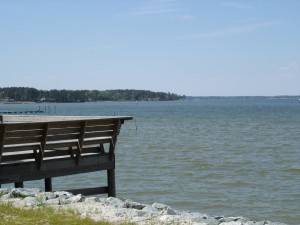Mathews High School 9889 Buckley Hall Rd. (Route 198 near 14)
 As a result of the the Clean Water Act, we have to show how we’re going to deal with the problem of waters condemned for excessive E. coli bacteria levels in a Piankatank/Milford Haven TMDL Implementation Plan. TMDL (total maximum daily load), is the maximum amount of nitrogen, phosphorus, sediment or bacteria a waterway can handle without exceeding acceptable levels.
As a result of the the Clean Water Act, we have to show how we’re going to deal with the problem of waters condemned for excessive E. coli bacteria levels in a Piankatank/Milford Haven TMDL Implementation Plan. TMDL (total maximum daily load), is the maximum amount of nitrogen, phosphorus, sediment or bacteria a waterway can handle without exceeding acceptable levels.
We are fortunate here that those before us kept the waters clean, and the only factor we need to address for 16 specific areas* in Mathews, Gloucester and Middlesex is the bacteria in the water. Currently, the recreational standards are met, but not those for shellfish. While shellfish water standards are much stricter than recreational standards, we don’t have the regulatory option to downgrade the use of our bays, creeks or rivers. Commonwealth policy states “the existing uses shall be maintained and protected.”
The first TMDL public meeting last May in Hartfield brought up a lot of questions and concerns. There were two work group (residential and business) meetings and a steering committee meeting and many emails since then to cover each point and to challenge the numbers and statistics first presented last year. I am very pleased to say that the state agency people from DCR and DEQ took our concerns input to heart and have updated the numbers and facts based on actual counts where available, and best estimates provided by local citizens where exact numbers were impossible. They have also affirmed there is no intention to force us into any HRSD expansions.
We still need to review the Implementation Plan at this public meeting in February, but I believe we can accept and live with the plan. Please make every effort to attend. This is something that affects all of us in one way or another. If you or a neighbor cannot attend, there is a 30-day comment period after the meeting. At that point, after any changes made as a result of the meeting or comments, the plan is ours to follow for the next 10 years.
*The areas to be covered by this IP, in addition to parts of the Piankatank River, are:
Mathews: Edward and Barn Creeks on Gwynn’s Island; Cobbs, Queen/Winder, Lanes, Stutts, Morris, Hudgins, and Billups Creeks
Gloucester: Harper, Dancing (Dancer), Ferry, French’s Creeks
Middlesex: Wilton, Healy Creeks


